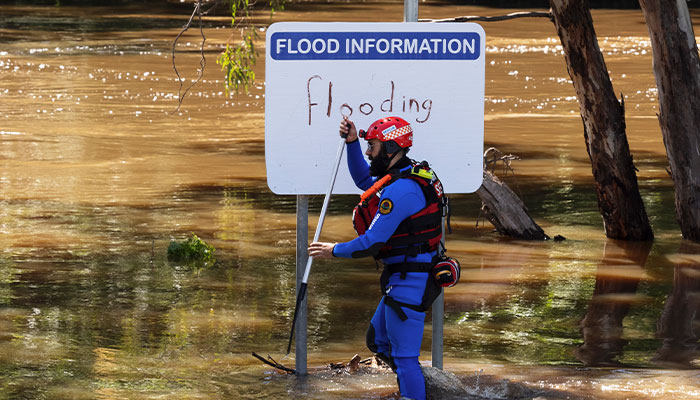La Nina is a particular ocean and atmospheric phenomenon that has a significant impact on global weather. La Nina (which means little girl in Spanish) and El Nino (which means little boy) are part of the El Nino-Southern Oscillation (ENSO).

Gathering storm: It's hard to predict how often La Nina is going to happen because of climate change but it is likely to be more frequent, and more extreme.
ENSO has three phases: the neutral phase, the El Nino phase – which causes droughts and bushfires – and the current La Nina phase that brings more frequent and heavier rainfall.
La Nina is caused by large-scale cooling of surface ocean temperatures in the eastern and equatorial Pacific Ocean, close to South America and Central America.
Coupled with trade winds, this brings warmer surface ocean temperatures to the western Pacific Ocean north of Australia.
According to the Bureau of Meteorology, La Nina and El Nino have more effect on climate variability in Australia than any other factors.
Heavy rain, cyclones and floods
La Nina causes floods and increases cyclone risk. The summer of 2010/11 was a significant La Nina event. Major flooding occurred throughout Victoria and Queensland.

On the ground: An SES worker in Forbes in November prepares to launch a flood boat ... already this year, floodwaters have affected large parts of inland NSW.
In Far North Queensland, Tropical Cyclone Yasi made landfall. More than 37 people died across the state and it wiped out most of the banana crop causing skyrocketing prices. It affected close to 30,000 homes and businesses in Brisbane.
The risk of cyclones extends from Coff Harbour in the east, across northern Australia, and down as far as Perth on the west coast.
Historical events such as the Coolangatta Cyclone in 1954 impacted areas that are now highly urbanised. If a similar event was to occur today the impacts would be severe.
Events such as La Nina and the resulting flooding can also have major mental health implications on people, caused by the anxiety, loss of property and livelihood.
Already this year, floodwaters have affected large parts of inland New South Wales and Queensland, inundating homes and businesses and isolating townships. In coming weeks, rising rivers will have a domino effect, flooding more towns downstream as the water travels to the coast.
Also, La Nina doesn't mean there won't be bushfires either in eastern and northern Australia this summer.
There probably won't be the scale of the 2019-2020 Black Summer fires, as forests won't burn as easily, but there will be significant grass growth with the increased rain and this can lead to grass fires.
In other parts of the world, La Nina has also caused extreme storms and flooding - particularly in British Columbia in Canada. Indonesia and Southeast Asia can also expect higher than average rainfall.
How to prepare if La Nina causes floods near you
Just as in a bushfire season, during La Nina it's also important to stay abreast of the news and flood warnings in your area so that you can be prepared.
If you live in a floodplain or near the coast or a river, flood waters can rise quickly. You may have a flood warning days ahead or only hours.
- LIsten to flood warnings regularly.
- Decide your evacuation route and where you'll evacuate to (evacuation centre, friend or relatives' property).
- Never enter floodwaters for any reason - it could be lethal.
Events such as La Nina and the resulting flooding can also have major mental health implications on people, caused by the anxiety, loss of property and livelihood.
It's hard to predict how often La Nina is going to happen because of climate change but it is likely to be more frequent and more extreme. Australia has experienced 18 La Nina events since 1901 and 12 of them led to extreme flooding in eastern Australia.
Andrew Gissing is an adjunct research fellow at Macquarie's Department of Environmental Sciences






